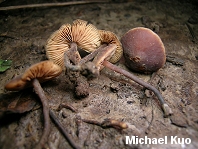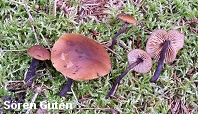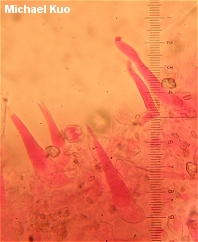| Major Groups > Gilled Mushrooms > Macrocystidia cucumis |

|
Macrocystidia cucumis [ Basidiomycetes > Agaricales > Marasmiaceae > Macrocystidia . . . ] by Michael Kuo There is no denying that Macrocystidia cucumis is an LBM ("Little Brown Mushroom"), not likely to attract the attention of most mushroom hunters. Aside from the fact that it smells strongly of cucumbers or fish, it has few easily observed features separating it from dozens (even hundreds) of look-alikes--and it can't even muster up a stable spore print color to help narrow down the possibilities; the color of the print ranges from whitish to pinkish, yellowish, or brownish. Under the microscope, however, Macrocystidia cucumis is very distinct and very cool. As its genus name suggests, it is covered from head to toe with enormous cystidia that can be seen even at low magnifications. Rickenella fibula looks similar under the microscope, but only under the microscope; it is bright orange. Description: Ecology: Saprobic; terrestrial; growing alone, gregariously or in troops in woods, disturbed ground, grassy areas, gardens, and so on; summer and fall (or winter in warm climates); fairly widely distributed in North America (documented in the Pacific Northwest, Illinois, Ohio, and Quebec) but seldom collected. Cap: 1-6 cm across; bell-shaped at first, becoming broadly bell-shaped, broadly convex, or nearly flat; smooth, silky, or very finely velvety; dark reddish brown, often with a paler margin; fading with age. Gills: Attached to the stem (sometimes by a notch); close; whitish, becoming yellowish to pinkish yellow. Stem: Up to 8 cm long and 5 mm thick; more or less equal; dry; finely velvety; tough; colored like the cap, but paler above and darker below. Flesh: Insubstantial; brownish. Odor and Taste: Odor strong, reminiscent of cucumbers or fish; taste mild or slightly fishy. Spore Print: Variable; whitish, pinkish, dirty yellowish, pale pinkish brown. Chemical Reactions: KOH dark olive, then gray on cap surface. Microscopic Features: Spores 7-9 x 3-4.5 µ; smooth; elliptical; inamyloid. Enormous, lanceolate cystidia (up to 90 µ long and over 20 µ wide) on cap surface, gills, and stem surface. REFERENCES: (Persoon, 1796) Josserand, 1934. (Fries, 1821; Saccardo, 1887; Breitenbach & Kränzlin, 1991; Lincoff, 1992; Laessoe & Lincoff, 2002.) Herb. Kuo 09220603. This site contains no information about the edibility or toxicity of mushrooms. |
© MushroomExpert.Com |
|
Cite this page as: Kuo, M. (2007, March). Macrocystidia cucumis. Retrieved from the MushroomExpert.Com Web site: http://www.mushroomexpert.com/macrocystidia_cucumis.html |



